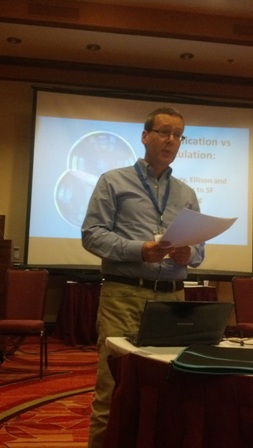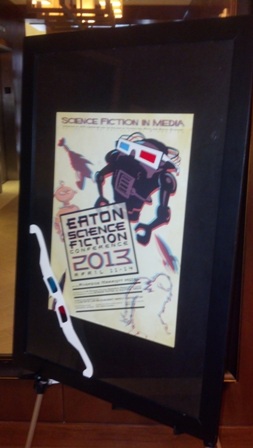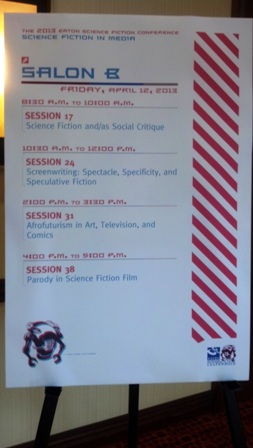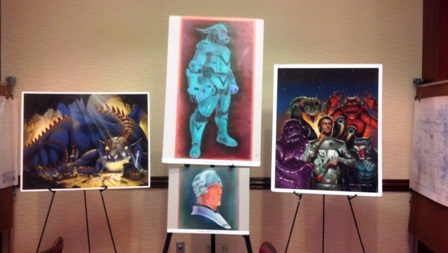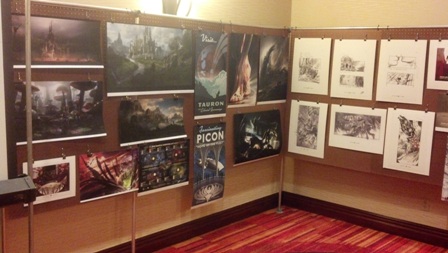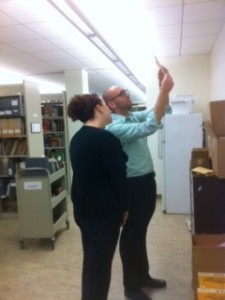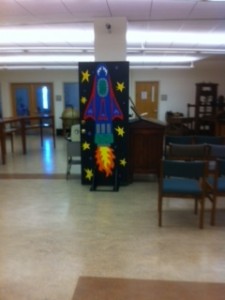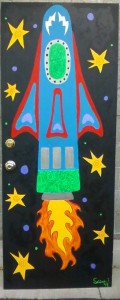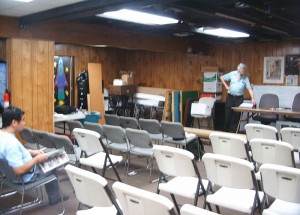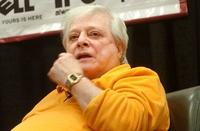This article of mine was originally posted on Trufen.net in October 2004.
From-purple-fingers-to-pixel-flingers: When you go, your fanzines stay here – a rule made to avoid cluttering up all Eternity like one big Slanshack. So what will you do to make sure they have a nice warm home?
One solution is to donate them. Pick out a library that is building a fanzine collection. Three ambitious libraries have websites that let you step in and take a virtual tour of their fanzine holdings – UC Riverside’s Eaton Collection, Temple University and the National Library of Australia.
Eaton Collection: The niftiest and most fannish website shows off the Eaton Collection at the University of California, Riverside. Curator George D. Slusser, Ph.D. has put a lot of ingenuity into this display. On the front page, the animated rocket of Fanac blazes above a background that resembles a faded old Twiltone fanzine cover, complete with two rusty staples in the margin. Five icons link to the website’s main divisions – watch how they animate when you click on them!
The foundations of the Eaton Collection’s fanzine catalog came from Terry Carr, Rick Sneary, and Bruce Pelz. It is the most extensive fanzine collection available to researchers. When J. Lloyd Eaton donated his 6,000 hardcover sf books to UC Riverside he helped aim them in the right direction. Bruce Pelz gave them 190,000 fanzines. The collection also has Rick Sneary’s personal correspondence, a unique fanhistorical archive.
Slusser’s website shows remarkable sensitivity to fanzine fandom’s subtle nuances. You can’t get more “inside” than to quote Arnie Katz (from The Trufan’s Advisor) in making a point about print-versus-electronic fanzines. Equally delightful is Slusser’s impatience with the claims of teenaged faneditor Harlan Ellison: “[His fanzine’s] cover promises ‘Ponce de Leon’s Pants,’ a fantasy by Mack Reynolds, which is nowhere inside the covers. Why bother to copyright this stuff?”
Of course, Slusser isn’t completely perfect either – for example the Carr Collection page refers to “Bob Bergeron” as the editor of Warhoon and Linda Bushyager’s “Grandfalloon.”
Then there is the unintentional irony. When Slusser says “The Carr fanzines are stored in acid-free containers in acid-free boxes” I’m sure he means they were acid-free before Richard Bergeron’s prose was slipped inside.
Temple University: Another zine collection is on the opposite coast. Temple University (in Philadelphia) accepted donation of the Paskow Science Fiction Collection in 1972. It has grown since then to 30,000 volumes (plus other stuff, like manuscripts, they can only gauge by the cubic foot… sounds like my office!) Their catalog of fanzine holdings is available at the Paskow Collection’s modest website.
Lots of popular fanzines are represented, though like the Platte River the collection is a mile wide but only an inch deep. There’s one issue of Mimosa, two issues of File 770, the first three issues of Trap Door, and so on. There are whole handfuls of a few other zines, for example, seven issues of Dick Geis’ Psychotic. And a like number of issues of Locus — just none dating later than when Charlie Brown lived in Boston!
Surprisingly, some of the most prolific fanzines are missing entirely. There are no issues of Ansible at all. (But how long can the Paskow Collection be kept uncontaminated, when anybody with an internet connection and a printer can own a complete run?)
National Library of Australia: On the far side of the world, the National Library of Australia owns a fanzine collection with a different slant, primarily Australian media fanzines contributed by long-time Star Trek fan, Sue Batho (formerly Smith-Clarke).
Unfortunately, the webpage about her collection is full of grindingly earnest prose, a jarring contrast to Batho’s appreciation for good entertainment. The tendency begins with the site’s description of Batho herself:
“It would not be unfair to say that Susan Smith-Clarke is one of the founding mothers of media SF fandom in Australia. The accompanying history of Star Trek fandom shows that Susan Smith-Clarke has been involved in many ways and through many years with fandom.”
Z-z-z-z-t — Wha’? I’m sorry, I nodded off there. Not that the earnest narrative completely smothers the subject. Batho’s personal sense of humor peeks through whenever zines are called by their titles, though I suspect the writer picked up some of them with a pair of tongs, for example:
“In this collection, are a number of issues of The Captain’s Briefs….”
However, for newcomers to the field the webpage explains basic terms with unexpected fannishness. Its definition of fanzine reads:
“The actual word means a magazine produced by a fan. Fan itself means, of course, a SF fan, just as Fandom, the collective noun, means SF fandom and nothing else. A non-fan is a mundane, which is why the word does not need any qualification.”
Exactly.
Your Fate Is in Your Hands: When you decide to donate your fanzines, there will be two general questions to think about.
The first question is: Do you want to send them to the place having the most success in acquiring and presenting its collection, or do you want to strengthen a collection that looks like it needs a boost?
It’s not a casual decision. In researching this article I was disappointed to find nothing online about the fanzines held by Bowling Green State University’s Department of Popular Culture. They had an accumulation (it wasn’t organized enough to deserve being called a collection) when I attended there in 1975, most of it donated by Vern Coriell (founder of the Burroughs Bibliophiles.)
The second question is: How will you make sure the transfer happens?
You can do it in your lifetime (as Bruce Pelz did) or through a properly drafted will. By all means, avoid Harry Warner’s mistake of leaving them to the local church and hoping things work out!
One last thought — the representative from the Eaton Collection told John Hertz they are perfectly happy to receive duplicates of zines already in the collection, feeling that makes the holdings more accessible to researchers, the same as having more than one copy of a rare book.
Update 03/05/2009: Updated the links to the Eaton and Paskow collections.

